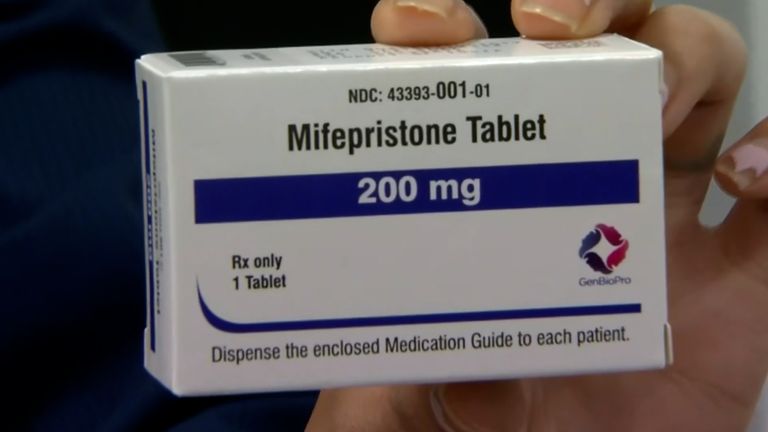How Abortion Bans Endanger Women’s Lives: “My Wife Almost Bled Out in Our Bathroom—We Can’t Let This Happen to My Daughter” | US News
Note: This article discusses a miscarriage that may be upsetting for some readers.
“We overturned Roe vs Wade,” stated President-elect Donald Trump earlier this year, referencing the Supreme Court decision in 2022 that removed the legal right to abortion for millions of American women.
About 36 days later, Ryan Hamilton, a Texas radio host, discovered his wife unconscious “in a large pool of blood” on the bathroom floor, their deceased baby still within her after she had been denied abortion care.
“I want people to realize that this is an ongoing reality and that abortion bans impact women experiencing incomplete miscarriages, like my wife,” Mr. Hamilton shared with Sky News.
“Women have literally lost their lives, and what I desire most is to ensure that my daughter’s future does not involve her bleeding out on a bathroom floor as her mother almost did.”
‘She was tortured for four days by the state of Texas’
In 2021, Texas enacted strict abortion regulations, prohibiting the procedure after five weeks of pregnancy.
However, after the reversal of Roe vs Wade the following year, the state took an even stricter approach, allowing abortions only to save a woman’s life or to prevent “substantial impairment of a major bodily function”.
Even though Texas provides such exceptions, doctors and women argued in court last year that the law is so ambiguous that physicians hesitate to perform abortions for fear of criminal charges.
Mr. Hamilton argues that this lack of clarity contributed to his wife’s near-fatal experience during her miscarriage.
“There’s no indication of how dire a woman’s situation has to be for doctors to legally perform the abortion care she requires,” he said.
While his one-year-old daughter cooed in the background, Mr. Hamilton described how his wife, aged 37, was 13 weeks pregnant when she experienced a miscarriage with their second child.
Upon realizing something was amiss, the couple went to a local medical facility in rural Texas, where they learned the baby had no heartbeat.
His wife, who has requested anonymity, was given misoprostol, commonly known as the abortion pill.
That was a Thursday, Mr. Hamilton recalls, but since it was late in the day, they couldn’t acquire the pill, forcing his wife to endure a “tormenting” night with their deceased baby still inside her.
When dawn broke, Mr. Hamilton went to the pharmacy for the pill. However, after his wife took the first dose, they called the medical center to report concerning symptoms, noting significant bleeding.
They sought an alternative to the pill, but the on-call doctor advised them to continue with the second dose and observe the blood’s color.
Mr. Hamilton recalled: “They asked me what color the blood was, advising it should be brown. I responded, ‘It’s bright red,’ and they said ‘That’s not right.’”
“So while we were in the midst of losing our baby… we were instructed to focus on the color of the blood in the toilet.”
After an agonizing night of what resembled early labor, Mr. Hamilton and his wife returned to the medical center, hoping for further assistance. However, the doctor on duty stated that given the “current stance,” he wouldn’t prescribe additional misoprostol and had no other options to provide.
“We stood in the parking lot with our then nine-month-old daughter in the truck, trying to determine our next steps, as the risk of sepsis loomed large if we were to leave the deceased baby inside her,” Mr. Hamilton recounted.
Eventually, they opted to go to another hospital about an hour away. Upon arriving, his wife underwent more examinations, only to confirm what they already knew—that their baby had no heartbeat.
At this point, she was “bleeding profusely,” he noted, “bleeding non-stop, soaking through postpartum pads.”
Mr. Hamilton stated that the doctors “vanished for hours,” only to return later and decline to perform dilation and curettage (D&C), a procedure to remove the fetus. Instead, they sent the couple home with a third dose of misoprostol.
“Essentially, they indicated she wasn’t close enough to death to justify the procedure since she needed to meet the life-of-the-mother exception under Texas law,” he explained.
“It was a nightmare scenario, and my poor wife was tormented for four days by the state of Texas,” he lamented.
Sky News has reached out to Texas state officials for a statement.
According to online abortion service Women on Web, medical abortions remain “effective and safe” up to 12 weeks of pregnancy. Beyond that point, although the medication may still work, the risks of complications rise, as does the likelihood of needing post-procedure medical attention.
‘I feared for her life’
Mr. Hamilton recounted how, following the third dose of the abortion pill, his wife woke up on Sunday with even heavier bleeding.
“I wrapped her in a heating blanket; she was clammy and cold. I propped her head up on a pillow, and it was the first moment I genuinely feared for her life,” he said.
While checking on their daughter, he noticed a missed call from his wife. Rushing back, he found her “slumped on the floor, surrounded by a massive pool of blood.”
He lifted her unconscious body into the truck, secured their daughter, and sped to a third hospital seeking urgent care.
As “she was close enough to death,” she received life-saving treatment, regained consciousness, and slowly began to recover.
According to an analysis shared with NBC, maternal mortality rates in Texas surged after the state implemented its five-week abortion ban in 2021.
Between 2019 and 2022, the rate of pregnant women who died in Texas rose by 56%, compared to just an 11% increase nationwide during that same period, as per a study of federal public health records conducted by the Gender Equity Policy Institute.
“We will carry that torturous experience with us for the rest of our lives,” Mr. Hamilton expressed.
What is the potential impact of a second Trump administration on abortion rights?
The implications of Trump’s second term, set to commence on January 20, remain uncertain as the president-elect has expressed shifting views on the subject.
During his prior presidency, he supported a House bill that aimed to ban abortions nationwide after 20 weeks.
In March, he indicated he would endorse a nationwide restriction on abortions post-15 weeks of gestation.
However, in the final phases of his most recent campaign, where his Republican Party regained control of both Houses, the 78-year-old stated he would not implement a federal abortion ban and would instead allow individual states to determine their abortion policies.
At the end of August, Mr. Trump—whose wife Melania recently published a memoir expressing support for abortion rights—strongly indicated that the six-week abortion ban in his home state of Florida was “too short.”
Read more:
‘My baby lived for just 93 minutes’
US Supreme Court preserves women’s access to abortion pill
Facing intense criticism from anti-abortion groups, Mr. Trump swiftly countered, declaring just a day later that he would vote “no” on a failed ballot measure aimed at expanding abortion access until fetal viability, which is around the 24th week of pregnancy.
Nancy Northup, CEO of the Center for Reproductive Rights, described his re-election as a “deadly risk” to reproductive health.
She noted that due to the overturning of Roe vs Wade, abortion has either been outright banned or severely restricted in 17 of the 50 states in the US.
As the presidential election results emerged, there were reports of stockpiling abortion pills, while Plan C, which advocates for online abortion medication access, reported a surge in traffic to its website from 500 to 80,000 searches in a single day following Trump’s significant victory.
According to Ms. Northup, “The unnecessary and brutal harm inflicted by the first Trump administration has created a reproductive health crisis across large areas of the United States, resulting in numerous women’s deaths that are likely just the tip of the iceberg.”
“A second Trump administration will exacerbate these harms with potentially even graver outcomes,” she cautioned.
“It will seek to eliminate the availability of medication abortion by mail, which has been a crucial resource in the post-Roe landscape,” she added.
There are also concerns it will attempt to silence organizations, both domestic and international, from advocating for abortion rights and providing care, even with their non-US funding.
“Without Trump’s reversal of Roe vs Wade, none of this turmoil would be occurring,” reflected Mr. Hamilton, alluding to the women who have died or narrowly escaped death due to complications arising from the denial of necessary care.
“The emphasis shifts from my wife’s well-being to the legality of the procedure.”
At the core of anti-abortion advocacy lies a belief in the sanctity of life.
“By opposing abortion, we recognize the humanity of the unborn, which energizes our efforts to protect the lives of those children,” asserts Americans United for Life.
Mr. Trump’s campaign team has been contacted for comments.






